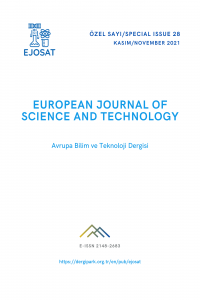Öz
Pervanesiz fanların geliştirilmesinden sonra, fan modelleriyle ilgili dizayn düşünceleri değişti. Bununla birlikte, geometric parametreler üzerinden optimum bir kanatsız fan geliştirmek, gelecekteki olası uygulamaları için kaçınılmazdır. Bu çalışmada, Coanda yüzey eğriliği, kanatsız fan kesit kalınlığı ve nozul çıkışı açıklığı gibi üç geometrik parametrenin farklı pervanesiz fan tasarımlarının performansına etkisi araştırılmıştır. Bu araştırma, pervanesiz fanların performansı ve ortalama çıkış hızı üzerindeki bu üç parametrenin etkilerini daha iyi anlamak için sayısal simülasyonlar kullanır. Pervanesiz fan kesit boşluğu içindeki havanın hız dağılımını ve nozul çıkışındaki ortalama çıkış hızı büyüklüğünü gözlemlemek amacıyla üç boyutlu sayısal simülasyonlar yapmak üzere ANSYS-Fluent yazılımı kullanılmıştır. Basitleştirilmiş pervanesiz fan konsepti üzerinde, bu üç parametre değiştirilerek farklı pervanesiz fan kesitleri tasarlanmış ve bu modeller üzerinde CFD simülasyonları gerçekleştirilmiştir. Nozul çıkışı aralığının, beklendiği gibi fan çıkışı hızı üzerinde en güçlü etkiye sahip olduğu bulunmuştur. Öte yandan, seçilen diğer iki parametrenin pervanesiz fanın akış dağılımı ve aerodinamik performansı üzerinde önemli etkileri vardır. Fan kesiti genişliği, pervanesiz fan halkası iç akış türbülansı karakteristiği için çok önemli bir parametredir. Bu araştırma, pervanesiz fanların performansını iyileştirmede değerli olacak ve optimum fan tasarımı hakkında faydalı fikirler verecektir.
Anahtar Kelimeler
Pervanesiz fan Aerodinamik performans Hesaplamalı akışkanlar mekaniği (HAM) Üç boyutlu nümerik simülasyon Coanda yüzeyi.
Kaynakça
- Lin, S. C., & Huang, C. L. (2002). An integrated experimental and numerical study of forward–curved centrifugal fan. Experimental thermal and fluid science, 26(5), 421-434.
- Mohaideen, M. M. (2012). Optimization of backward curved aerofoil radial fan impeller using finite element modelling. Procedia engineering, 38, 1592-1598.
- Drăgan, V. (2012). A New mathematical model for Coandă effect velocity approximation. INCAS Bull, 4, 85-92.
- Li, G., Hu, Y., Jin, Y., Setoguchi, T., & Kim, H. D. (2014). Influence of Coanda surface curvature on performance of bladeless fan. Journal of thermal science, 23(5), 422-431.
- Jafari, M., Afshin, H., Farhanieh, B., & Sojoudi, A. (2016). Numerical investigation of geometric parameter effects on the aerodynamic performance of a Bladeless fan. Alexandria Engineering Journal, 55(1), 223-233.
- Shih, T. H., Liou, W. W., Shabbir, A., Yang, Z., & Zhu, J. (1995). A new k-epsilon eddy viscosity model for high Reynolds number turbulent flows. Computers & fluids, 24(3), 227-238.
- Rašuo, B., & Mirkov, N. (2014). On the possibility of using Coanda Effect for Unmanned Aerial Vehicles–a numerical investigation. PAMM, 14(1), 627-628.
- GAMMACK P D, NICOLAS F, SIMMONDS K J. “Bladeless fan, in Patent Application” US Patent 2009/0060710Al. United States, 2009.
Öz
After the development of bladeless fans, design considerations about the fan models have been changed. However, developing an optimum bladeless fan based on geometric parameters is essential due to their possible future applications. In this study, the effect of three geometric parameters such as Coanda surface curvature, bladeless fan cross-section thickness and nozzle outlet gap on the performance of different bladeless fan designs are investigated. These unique features have a significant impact on the bladeless fan's performance. This research uses numerical simulations to get a better understanding of the effects of these three parameters on the performance and the average outlet velocity of bladeless fans. To observe the velocity distribution of the air inside the bladeless fan chamber and average outlet velocity magnitude at the nozzle outlet, ANSYS-Fluent software is used to do three-dimensional numerical simulations. Based on a simplified bladeless fan concept, different bladeless fan cross-sections are designed by changing these three parameters and CFD simulations conducted on these models. It is found that the nozzle outlet gap has the strongest effect on the outlet velocity magnitude of the fan as expected. On the other hand, the other two parameters that choose have significant effects on flow distribution and aerodynamic performance of the bladeless fan. Fan cross-section thickness is a crucial parameter for the internal flow turbulence characteristics inside the bladeless fan ring. This research will be valuable in improving the performance of bladeless fans and will give useful ideas about optimum fan design.
Anahtar Kelimeler
Bladeless fan Aerodynamic performance Computational fluid dynamics (CFD) 3D numerical simulation Coanda surface.
Kaynakça
- Lin, S. C., & Huang, C. L. (2002). An integrated experimental and numerical study of forward–curved centrifugal fan. Experimental thermal and fluid science, 26(5), 421-434.
- Mohaideen, M. M. (2012). Optimization of backward curved aerofoil radial fan impeller using finite element modelling. Procedia engineering, 38, 1592-1598.
- Drăgan, V. (2012). A New mathematical model for Coandă effect velocity approximation. INCAS Bull, 4, 85-92.
- Li, G., Hu, Y., Jin, Y., Setoguchi, T., & Kim, H. D. (2014). Influence of Coanda surface curvature on performance of bladeless fan. Journal of thermal science, 23(5), 422-431.
- Jafari, M., Afshin, H., Farhanieh, B., & Sojoudi, A. (2016). Numerical investigation of geometric parameter effects on the aerodynamic performance of a Bladeless fan. Alexandria Engineering Journal, 55(1), 223-233.
- Shih, T. H., Liou, W. W., Shabbir, A., Yang, Z., & Zhu, J. (1995). A new k-epsilon eddy viscosity model for high Reynolds number turbulent flows. Computers & fluids, 24(3), 227-238.
- Rašuo, B., & Mirkov, N. (2014). On the possibility of using Coanda Effect for Unmanned Aerial Vehicles–a numerical investigation. PAMM, 14(1), 627-628.
- GAMMACK P D, NICOLAS F, SIMMONDS K J. “Bladeless fan, in Patent Application” US Patent 2009/0060710Al. United States, 2009.
Ayrıntılar
| Birincil Dil | İngilizce |
|---|---|
| Konular | Mühendislik |
| Bölüm | Makaleler |
| Yazarlar | |
| Yayımlanma Tarihi | 30 Kasım 2021 |
| Yayımlandığı Sayı | Yıl 2021 Sayı: 28 |


